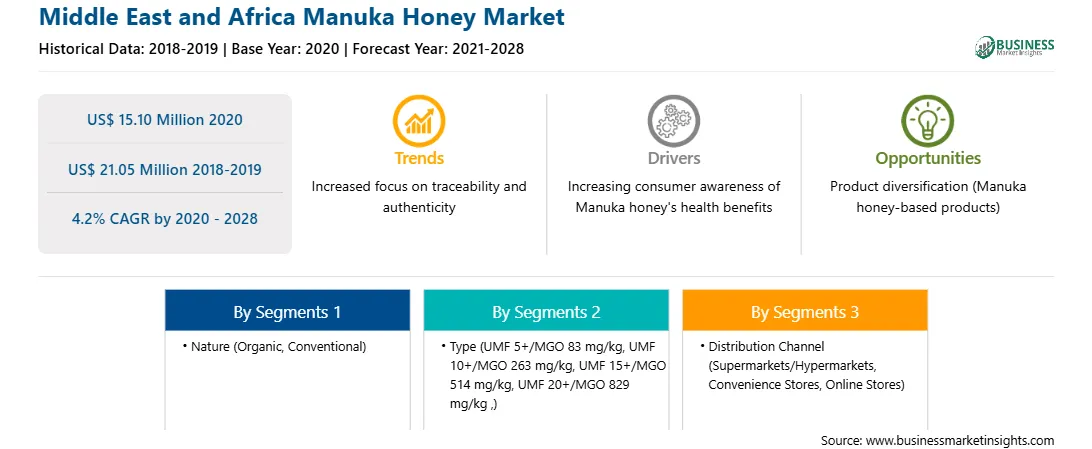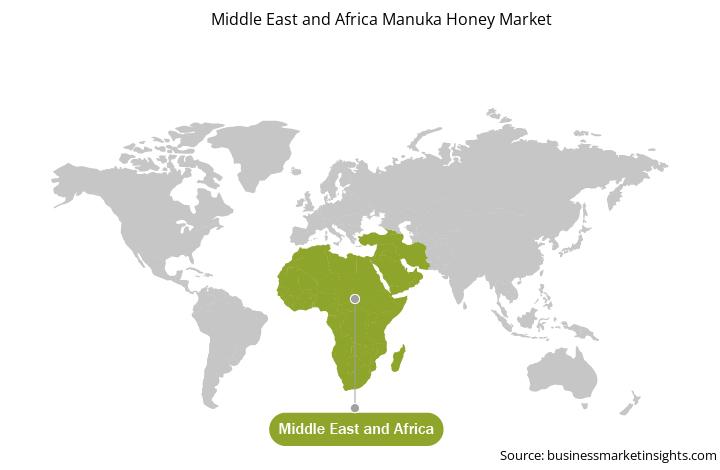The Middle East and Africa region include countries such as South Africa, Saudi Arabia, UAE, and the Rest of the Middle East and Africa. The Middle East countries such as Kuwait, Saudi Arabia, and the UAE have experienced a shift in the socio-economic condition, food eating habits, lifestyle and economic status, and health patterns in the past four decades. This shift has occurred due to the increase in income owing to accumulated oil revenues. Also, these countries are known for their strong economic status. The market in the Middle East and Africa is also experiencing rapid development with the growth of market in countries such as Iraq, Yemen, and Iran. The consumption of manuka honey in Middle East and Africa is evolving, which has pushed the key players to diversify the emergence of new products and packaging reformation in terms of manuka honey market. The growing distribution channel in the region supports the market for manuka honey. The adoption of manuka honey as a healthy alternative to sugar also increases the demand for manuka honey in Middle East & Africa. The common practice of using unconventional sweeteners is promoting the demand for manuka honey in the region. The intense flavor and sweetness of manuka honey make it a potential sweetener and table sugar replacer. The consumers in the region are becoming health conscious and opt for natural and nutritional products. Manuka honey is recognized to contain low fat; therefore, it is gaining traction among the health-conscious population. The rising application of honey is another factor adding to the growth of the manuka honey market
Turkey has the highest COVID-19 cases in the Middle East and Africa region, and is followed by South Africa and UAE, among others. UAE was the first country in the Middle East and Africa to report a confirmed case of coronavirus. The coronavirus pandemic has affected economies and industries in various countries due to lockdowns, travel bans, and business shutdowns. The food & beverages industry is one of the major industries suffering serious disruptions such as supply chain breaks, technology events cancellations, shutdown of production plants, etc., because of this pandemic. The shutdown of various plants and factories in the Middle East, and Africa has affected the global supply chain and negatively impacted the manufacturing, delivery schedules, and sales of various goods. Furthermore, various companies have already announced possible delays in product deliveries and slump in future sales of their products. All these factors are anticipated to affect the food & beverages, personal care, and animal feed industries in a negative manner and thus act as restraining factor for the growth of various markets related to this industry in the coming months. The market for manuka honey is impacted by the pandemic due to shortfall in production along with limited transportation facilities.

Strategic insights for the Middle East and Africa Manuka Honey provides data-driven analysis of the industry landscape, including current trends, key players, and regional nuances. These insights offer actionable recommendations, enabling readers to differentiate themselves from competitors by identifying untapped segments or developing unique value propositions. Leveraging data analytics, these insights help industry players anticipate the market shifts, whether investors, manufacturers, or other stakeholders. A future-oriented perspective is essential, helping stakeholders anticipate market shifts and position themselves for long-term success in this dynamic region. Ultimately, effective strategic insights empower readers to make informed decisions that drive profitability and achieve their business objectives within the market.

| Report Attribute | Details |
|---|---|
| Market size in 2020 | US$ 15.10 Million |
| Market Size by 2028 | US$ 21.05 Million |
| Global CAGR (2020 - 2028) | 4.2% |
| Historical Data | 2018-2019 |
| Forecast period | 2021-2028 |
| Segments Covered |
By Nature
|
| Regions and Countries Covered | Middle East and Africa
|
| Market leaders and key company profiles |
The geographic scope of the Middle East and Africa Manuka Honey refers to the specific areas in which a business operates and competes. Understanding local distinctions, such as diverse consumer preferences (e.g., demand for specific plug types or battery backup durations), varying economic conditions, and regulatory environments, is crucial for tailoring strategies to specific markets. Businesses can expand their reach by identifying underserved areas or adapting their offerings to meet local demands. A clear market focus allows for more effective resource allocation, targeted marketing campaigns, and better positioning against local competitors, ultimately driving growth in those targeted areas.

The manuka honey market in Middle East & Africa is expected to grow US$ 21.05 million by 2028 from US$ 15.10 million in 2020. The market is estimated to grow at a CAGR of 4.2% from 2020 to 2028. The rise in disposable income and the need to enhance physical appearance among consumers propel the demand for self-grooming products. The improvement in quality of life, the positive effects of personal care on self-esteem and social interaction, and the gradual consumer shift toward luxury and premium self-grooming products are a few factors that are expected to drive the market growth during the forecast period. Manuka honey, sourced from the Manuka plant in Australia and New Zealand, goes beyond the regular table honey. Its anti-inflammatory and antibacterial properties make it best suitable ingredient for several skin-related products. Manuka’s properties are best used in treating acne and as an effective moisturizer. Further, manuka is full of active ingredients and methylglyoxal that makes it potent all these are the factors likely to influence the market growth.
Middle East & Africa manuka honey market is segmented based on nature, type, and distribution channel Based on nature, the Middle East & Africa manuka honey market based on nature is segmented into organic and conventional. The conventional segment accounted for the highest share in the market in 2019 and organic segment is expected to be fastest growing during forecast period. Based on type, is segmented into UMF 5+/MGO 83 mg/kg (ppm), UMF 10+/MGO 263 mg/kg (ppm), UMF 15+/MGO 514 mg/kg (ppm), and UMF 20+/MGO 829 mg/kg (ppm). The UMF 15+/MGO 514 mg/kg (ppm) segment accounted for the highest share in 2019 and UMF 20+/MGO 829 mg/kg (ppm) segment is expected to be the fastest growing during forecast period. Based on distribution channel, the market is segmented into supermarkets/hypermarkets, convenience stores, online stores and others. The supermarket/hypermarket segment accounted for the highest share in 2019 and online store segment is expected to be the fastest growing during forecast period.
A few major primary and secondary sources referred to for preparing this report on manuka honey market in Middle East & Africa are company websites, annual reports, financial reports, national government documents, and statistical database, among others. Major companies listed in the report are 100% Pure New Zealand Honey; Arataki Honey; Comvita; Manuka Health; Oha Honey; Midlands Holdings; Capilano Honey Ltd; Streamland; and Wedderspoon Organic.
The Middle East and Africa Manuka Honey Market is valued at US$ 15.10 Million in 2020, it is projected to reach US$ 21.05 Million by 2028.
As per our report Middle East and Africa Manuka Honey Market, the market size is valued at US$ 15.10 Million in 2020, projecting it to reach US$ 21.05 Million by 2028. This translates to a CAGR of approximately 4.2% during the forecast period.
The Middle East and Africa Manuka Honey Market report typically cover these key segments-
The historic period, base year, and forecast period can vary slightly depending on the specific market research report. However, for the Middle East and Africa Manuka Honey Market report:
The Middle East and Africa Manuka Honey Market is populated by several key players, each contributing to its growth and innovation. Some of the major players include:
The Middle East and Africa Manuka Honey Market report is valuable for diverse stakeholders, including:
Essentially, anyone involved in or considering involvement in the Middle East and Africa Manuka Honey Market value chain can benefit from the information contained in a comprehensive market report.